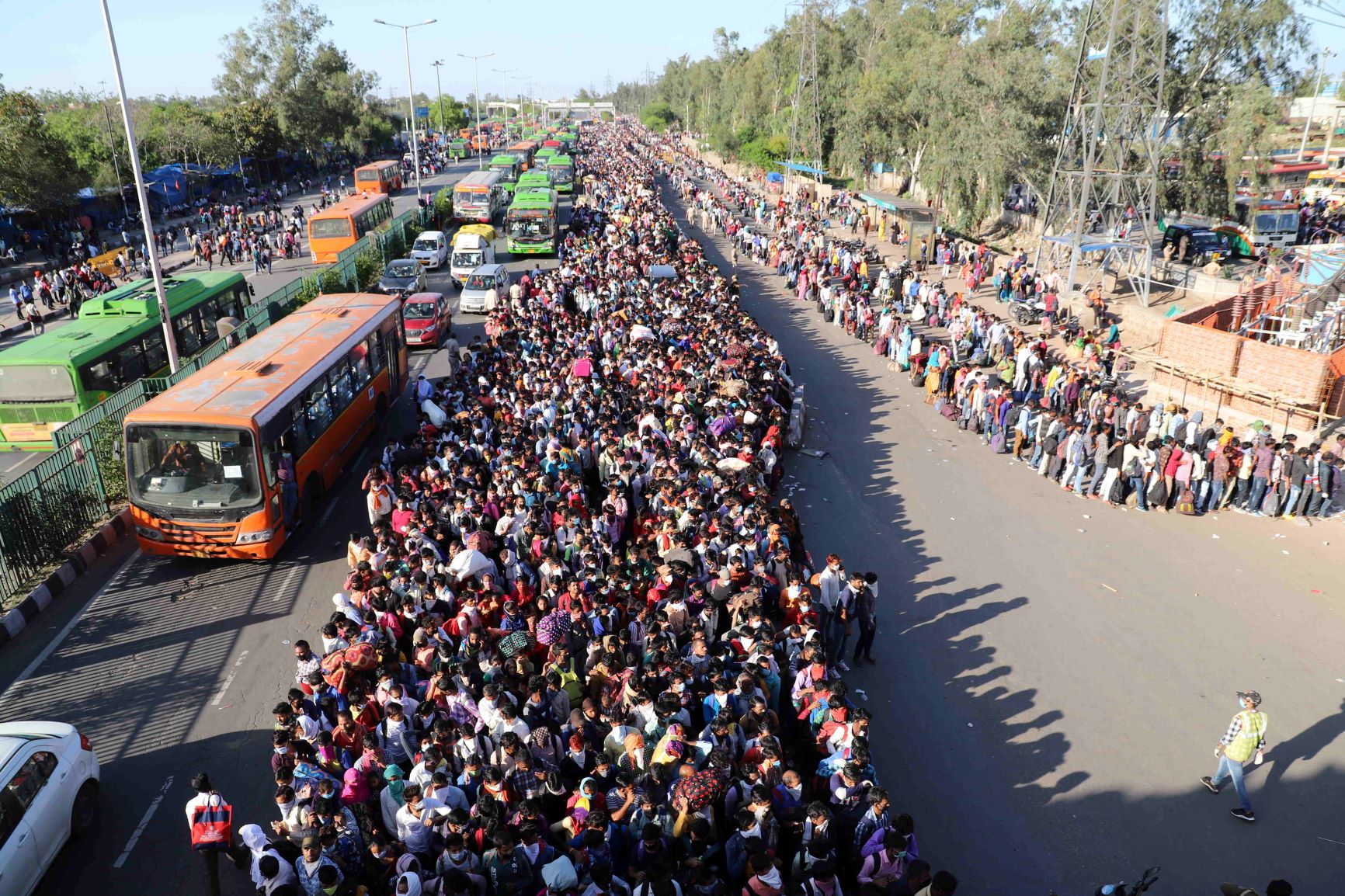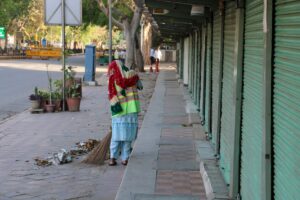Second wave wipes off economic revival hopes

Employment and household incomes are still way below their 2019 levels due to the shock of 2020 lockdown (MIG photos/Aman Kanojiya)
On April 7, after its Monetary Policy Committee meeting, the Reserve Bank of India, country’s central bank, maintained its projection for India’s GDP growth in the current fiscal at 10.5 pc, despite clear signs of the second wave of Covid-19 pandemic spreading in some parts of India, notably Mumbai, where the RBI is based. “The projection for real GDP growth for FY 2021-22 is retained at 10.5 pc, consisting of 26.2 pc in Q1, 8.3 pc in Q2, 5.4 pc in Q3 and 6.2 pc in Q4 of FY21-22,” announced Shaktikanta Das, governor of the RBI.
Less than a month later, on May 5, Das issued a fresh statement. “The financial year 2020-21 – the year of the pandemic – was drawing to a close, the Indian economy was advantageously poised, relative to peers. India was at the foothills of a strong recovery, having regained positive growth, but more importantly, having flattened the infections curve. In a few weeks since then, the situation has altered drastically. Today, India is fighting a ferocious rise in infections and mortalities. New mutant strains have emerged, causing severe strains on healthcare and medical facilities, vaccine supplies and frontline health personnel. The fresh crisis is still unfolding,” Das said.
In the three weeks since, the extent of damage caused by the second wave across India is still emerging, even as over half the country has been locked down for almost the entire month. Thus, it would be interesting to note how Das would portray the current situation and to what extent would his tenor and position change further, having already moved from optimism to a cautious one between April 7 and May 5.
Souring state of affairs
While Das may have so far been reserved in his statements, others have been more forthcoming about the extent of dangers that the Indian economy faces. Five days after Das sounded cautious, alarming data was released by Mahesh Vyas of Centre for Monitoring of Indian Economy, a leading economic research organisation based in Mumbai. Vyas said that the second wave of Covid-19 infections was clouding Indian economy’s prospects of recovery from the worst ever contraction suffered in 2020-21. Indeed, on April 1, the CMIE had projected a growth of 9.2 pc in current fiscal, but on May 10, it cut the growth expected to 8.7 pc as it expected GDP growth during the June 2021 quarter to be limited to 22 pc instead of 28 pc forecast in April.
But even this forecast assumed that the second wave peaks in mid-May 2021 and state governments relax curbs. “If the second wave of infections prolongs, India’s GDP will further get impacted negatively. The probability of this is high given the election rallies and large religious gathering India witnessed in April and suspected under-reporting of Covid-19 cases in some states,” Vyas underlined.
At the time, only Maharashtra, Karnataka, Rajasthan and NCT of Delhi had imposed lockdowns. Since then, the list has ballooned to include Tamil Nadu, Kerala, West Bengal, Bihar, Andhra Pradesh, Haryana, Madhya Pradesh and Odisha, besides most of north-eastern states. Thus, it is certain that the situation of the economy would have dramatically worsened in the past three weeks, with no sign of immediate improvement.

Unemployment, as per CMIE estimates, stood at 10 pc in May, up 2.8 pc in just one month (MIG photos/Varsha Singh)
It is bound to have had a serious negative impact on a whole lot of economic indicators, including employment, household incomes, consumer confidence and even the professional benchmarks like purchasing managers index that measures factories’ projections for production.
Employment and household incomes are still way below their 2019 levels due to the shock of 2020 lockdown. Consumer Pyramids Household Survey (CPHS) by CMIE suggest that average household income, despite recovering from the April 2020 slump, remained 9.7 pc below its year-ago level in November 2020 in nominal terms. The decline in real terms would be higher.
Where are the jobs?
The picture no prettier in employment as the number of people employed was 398 million in March 2021 as compared to the 2019-20 average of 403.5 million, implying that 5.4 million are yet to get back jobs lost in the first wave, even though a record high of 10 million additional workers have joined the farm labour numbers since most of the migrants returned to their villages and had no option but turn to working on farms. CMIE says that the job losses are predominantly among salaried people, of the order of 9.8 million, followed by businesses at 4.2 million. Unemployment, as per CMIE estimates, stood at 10 pc in May, up 2.8 pc in just one month.
Spending suffers setback
The data for the next lot is expected to be far worse once the impact of the second wave and the lockdowns in place becomes clearer. But households are taking no chances already, even as various economists battle over conflicting estimates about the way Indian economy would turn.
A survey by the RBI in March, involving 5,372 households in 13 major cities, said that only 24.7 pc expected spending on non-essential items to increase in 2021-22. This is the lowest percentage since May-July 2020 and the second lowest in the history. Households curtailing discretionary spending is a huge blow to hopes of a swift economic recovery for the Indian economy that gets nearly 60 pc of its real GDP through private consumption.
The results are more stark when contrasted with the consumer confidence in other large economies. While China has already roared back strongly in the first quarter of the calendar year, the United States economy has also picked up rapid pace, thanks in a very large part to the USD 1400 that President Joe Biden has put into every adult American’s pockets as part of his plan to revive the economy. This has led to one of the sharpest spikes in consumer confidence and spending in the world’s largest economy, which is now racing with China to be the fastest growing large economy in the world this year.

Survey by RBI in March of 5,372 households in 13 major cities said that only 24.7 pc expected spending on non-essential items to increase in 2021-22 (MIG photos/Varsha Singh)
For most Indians, these would sound as sour as the current consumer sentiments. The index of consumer sentiment declined by 1.5 pc in the week ended May 16, 2021. This was the fifth consecutive week of a fall in consumer sentiments. Cumulatively, the index has dropped 8.3 pc since the week ended April 11 and 9.1 pc since the last week of March 2021. CMIE says that such a fall is comparable to the fall seen in March 2020 and May 2020. The main reason for the fall remains the same a fall in household income and increased pessimism regarding their future.
The picture is scary from close up. In the week ended May 16, only 3.1 pc of the households reported that their incomes were higher than they were a year ago. The proportion of households saying that their incomes were better than a year ago has been falling steadily since the week ended March 21. From around the same time, the proportion of households stating that their incomes were worse than a year ago has been rising. Nearly 56 pc of the households reported a loss of income compared to a year ago, while the remaining 41.5 pc reported same income as last year. CMIE goes on to conclude that in effect it is safe to assume that well over 97 pc of Indian households have suffered a fall in real income.
In such a scenario, expecting a swift recovery, even if the lockdowns are ended, all restrictions removed and all sectors of the economy begin humming again, is just wishful thinking.









